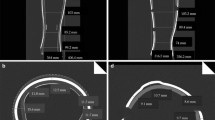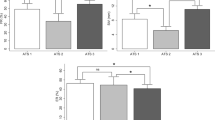Abstract
Football shin guards were evaluated against a kick from a studded boot.The bending stiffness of their shells, and their response when impacted by a stud, were assessed using finite element analysis (FEA) and determined experimentally.A test rig was constructed with the leg muscle simulated by flexible foam, with the force distribution along the tibia and to the lateral muscle measured using flexible force sensors.High-speed photography confirmed deformation mechanisms predicted by FEA.Load spreading from the stud impact site correlated with the guard shell bending stiffness.The best guards use shells of complex shape to increase their transverse bending stiffness.
Similar content being viewed by others
References
Ankrah, S. (2002)Protective materials for sporting applications — football shin guards, PhD thesis, University of Birmingham, Birmingham, UK.
Ankrah, S. & Mills, N.J. (2003) Analysis of ankle protection in football, accepted bySports Engineering.
Beiner, J.M. & Jokl, P. (2001) Muscle contusion injuries: a review.Journal of the American Academy of Orthopaedic Surgeons,9, 227–237.
Bir, C.A., Cassata, S.J. & Janda, D.H. (1995) An analysis and comparison of soccer shin guards.Clinical Journal of Sports Medicine,5, 95–99.
Boden, B.P. (1998) Leg injuries and shin guards.Clinics in Sports Medicine,17, 769–777.
BS EN 13061: 2001Protective Clothing — shin guards for association football players. British Standards, London.
Clarys, J.P. & Marfell-Jones, M.J. (1994) Soft tissue segmentation of the body and fractionation of the upper and lower limbs.Ergonomics,37, 217–229.
Clauser, C.E., McConville, J.T. & Young, W.T. (1969)Weight, volume and centre of mass of segments of the human body, AMRL-TR-69-70. Wright Patterson Air Force Base, Ohio.
Crisco, J.J., Hentel K.D., Jackson W.O., Goehner K. & Jokl P. (1996) Maximal contraction lessens impact response in a muscle contusion model.Journal of Biomechancis,29, 1291–1296.
Davies, O.L. & Mills, N.J. (1999) The rate dependence of Confor PU foams,Cellular Polymers,18, 117–136.
Ellis, H., Logan, B.M. & Dixon, A. (1994)Human Crosssectional Anatomy. Butterworth-Heinemann, Oxford.
Francisco, A.C., Nightingale, R.W., Guilak, F., Glisson, R.R. & Garrett, W.E. (2000) Comparison of soccer shin guards in preventing tibia fracture.American Journal of Sports Medicine,28, 227–233.
Giddings, V.L., Beaupre, G.A., Whalen R.T. & Carter D.R. (2000) Calcaneal loading during walking and running.Medicine and Science in Sport and Exercise,32, 627–634.
Gilchrist, A. & Mills, N.J. (1996) Protection of the side of the head.Accident Analysis and Prevention,28, 525–535.
Hawkins, R.D. & Fuller, C.W. (1999) A prospective study of injuries in four professional football clubs.British Journal of Sports Medicine,33, 196–203.
Heiner, A.D. & Brown, T.D. (2001) Structural properties of a new design of composite replicate femurs and tibias,Journal of Biomechanics,34, 773–781.
Lees, A. & Nolan, L. (1998) The biomechanics of soccer.Journal of Sports Sciences,16, 211–234.
Lees, A. & Cooper, S. (1995) The shock attenuation characteristics of soccer shin guards. In:Sport Leisure and Ergonomics (eds G. Atkinson & T. Reilly), pp. 130–135. Spon, London.
Mills, N.J. & Zhang, P. (1989) The effects of contact conditions on impact tests on plastics.Journal of Materials Science,24, 2099–2109.
Nyquist, G.W. Cheng, R., El-Bohy, A.A. & King, A.I. (1985) Tibia bending: strength and response.29th Stapp Car Crash Conference, Society of Automotive Engineers, Warrendale, PA.
Ogden, R.W. (1972) Large deformation isotropic elasticity.Proceedings of the Royal Society of London, Series A 328, 567–583.
Phillipens, M. & Wismans, J. (1989) Shin guard impact protection.IRCOBI Conference, pp. 650–676, INRETS, Bron, France.
Verdejo, R. & Mills, N.J. (2002) Performance of EVA foams in running shoes. In:The Engineering of Sport 4 (eds S. Ujihashi & S.J. Haake), pp. 580–587. Blackwell, Oxford.
Author information
Authors and Affiliations
Corresponding author
Rights and permissions
About this article
Cite this article
Ankrah, S., Mills, N.J. Performance of football shin guards for direct stud impacts. Sports Eng 6, 207–219 (2003). https://doi.org/10.1007/BF02844024
Issue Date:
DOI: https://doi.org/10.1007/BF02844024




